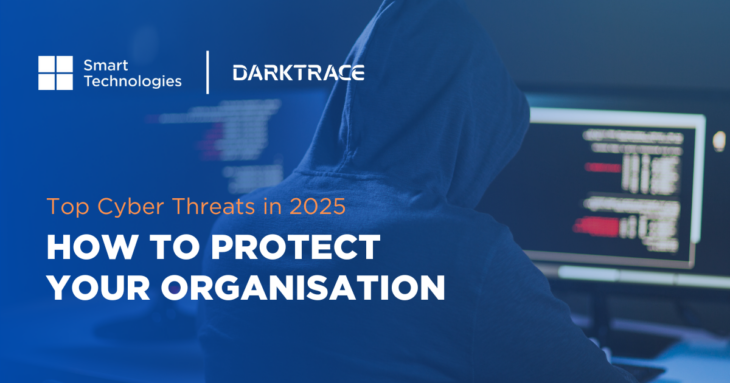
- April 4 2025
- Smart Technologies Ltd
As we progress further into 2025, the landscape of cyber threats continues to evolve at an alarming pace. Cybercriminals are becoming more sophisticated, employing advanced tactics and new technologies to bypass security defences. Insights from the Darktrace Annual Threat Report 2024 provide a clear view of the emerging trends and evolving threats that organisations must be aware of to protect their systems and sensitive data.
From the rise of advanced ransomware techniques to the growing risks associated with edge devices and SaaS applications, organisations face increasingly complex cybersecurity challenges. In this blog, we’ll break down the key threats outlined in the report and offer practical tips to help businesses protect themselves.
1. The Evolution of Ransomware: A Growing Threat
Ransomware has long been a significant cybersecurity threat, but heading into 2025, its tactics have become even more advanced. Cybercriminals have moved beyond traditional phishing-based attacks, incorporating new techniques such as SaaS-based attacks, exploiting vulnerabilities in IT systems, and using file-transfer technology to execute faster and more effective campaigns.
A key trend is the rise of Ransomware-as-a-Service (RaaS), which allows even those with minimal technical knowledge to launch devastating ransomware attacks. Variants like Akira, which uses RDP-based attacks, and LockBit, which exploits VMware vulnerabilities, are becoming more widespread, targeting industries such as finance, healthcare, and education.
To protect against ransomware, implement Zero Trust Security to enforce strict access controls across your network. Regularly update backup systems and test your incident response plans to minimise the damage caused by potential ransomware attacks.
2. Vulnerability Exploitation: The Danger Lurking at the Edge
In 2024, 29,000 vulnerabilities were discovered in edge devices and perimeter systems—a significant increase from 18,000 in 2020. With the growing adoption of IoT devices and the expansion of remote work infrastructures, these vulnerabilities are prime targets for cybercriminals. Exploiting weaknesses at the network’s edge allows attackers to bypass traditional security measures and infiltrate internal systems.
Darktrace’s report highlights the critical need to secure edge devices, as they are often overlooked in favour of more centralised infrastructure. Attackers are increasingly targeting these entry points, making them high-risk areas for breaches.
In 2025, Businesses need to focus on securing edge devices (e.g., IoT systems) and implement continuous monitoring to identify vulnerabilities. Leveraging AI-powered threat detection tools can help spot unusual patterns of activity that may signal a breach.
3. Identity-Based Attacks: Why SaaS Security is Critical
As organisations continue to rely heavily on SaaS applications, identity-based attacks have surged. Cybercriminals target stolen login credentials to gain unauthorised access to sensitive data, often through phishing or credential stuffing attacks that exploit weak or reused passwords.
Darktrace emphasises that robust identity management is critical to preventing these attacks. As more businesses move operations to the cloud, safeguarding user credentials is essential to avoid costly breaches.
Implement multi-factor authentication (MFA) and enforce strong password policies across all SaaS applications. Regular employee training on identifying phishing emails and malicious login attempts is also key to reducing the risk of credential theft.
4. Living-Off-the-Land (LOTL) Techniques: A Silent Threat
Living-off-the-Land (LOTL) techniques have become a go-to tactic for cybercriminals in 2024. Rather than relying on external malware, attackers use legitimate system tools to infiltrate networks and evade detection. This stealthy approach allows them to blend in with normal network activity, making it harder to detect an intrusion.
The report from Darktrace reveals that LOTL techniques are on the rise, as attackers use them to escalate privileges, exfiltrate data, or deploy additional malware without triggering security alarms.
Regularly audit your internal systems for any signs of unusual activity. Implement AI-based anomaly detection to help identify deviations from normal behaviour, enabling quicker detection of potential breaches.
5. Remote Access Trojans (RATs) and Malware-as-a-Service (MaaS): A Rising Concern
Remote Access Trojans (RATs) and Malware-as-a-Service (MaaS) have seen explosive growth in 2024. RATs allow attackers to remotely control compromised devices, often without the user’s knowledge. MaaS platforms enable cybercriminals to rent malware for use in large-scale attacks, even without technical expertise.
Darktrace’s report notes that RATs and MaaS are responsible for a significant portion of cyberattacks—46% and 57%, respectively—making them highly dangerous. These attacks open the door to widespread damage, data theft, and system compromise.
Invest in endpoint protection solutions to monitor for unauthorised remote access and suspicious activity. Regular software updates and patches are also essential to close vulnerabilities that RATs and MaaS exploit.
Conclusion
The Darktrace Annual Threat Report 2024 paints a stark picture of the evolving cybersecurity landscape. With ransomware evolving, vulnerabilities at the edge increasing, and identity-based attacks on the rise, organisations must be proactive in their cybersecurity strategies.
By adopting a risk-based approach and leveraging emerging technologies like AI-powered threat detection, businesses can bolster their defences against complex threats. Best practices such as Zero Trust Security, endpoint protection, and strong identity management are essential to reducing the risk of a successful cyberattack.
Now is the time to act—don’t wait for a breach to happen. Equip your organisation with the right tools and strategies to stay ahead of evolving threats in 2025.
Ready to fortify your organisation’s defences? Our experts are here to help. Get in touch with us to discuss how we can tailor a comprehensive cybersecurity strategy for your unique needs. Stay proactive and secure your future—contact us now!